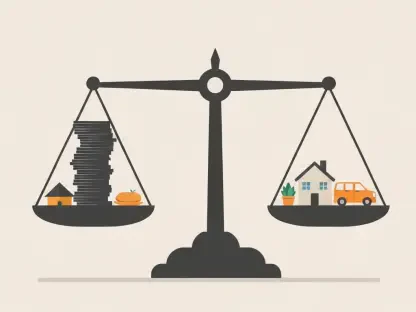In the ever-evolving world of global finance, a striking development has emerged from Ireland’s banking sector: AIB Group, a key player in the market, has slashed its loan growth forecast from an ambitious 5% to a cautious 3% for the current year. This adjustment paints a vivid picture of the hurdles facing financial institutions amid economic uncertainty and policy disruptions. With small and medium-sized enterprises (SMEs) in Ireland showing reluctance to borrow and renewable energy investments in the United States hitting roadblocks, AIB’s revised outlook serves as a critical indicator of broader market dynamics. This analysis dives deep into the factors driving this shift, unpacking the implications for the banking industry and exploring how strategic pivots could shape recovery. The discussion aims to provide stakeholders with actionable insights into navigating these turbulent waters.
Dissecting Market Trends: AIB’s Challenges and Projections
SME Lending Struggles: A Pulse on Ireland’s Economic Caution
A significant factor behind AIB’s tempered loan growth projection lies in the hesitancy of Irish SMEs to take on new debt. In the early months of this year, loan demand has noticeably weakened as businesses grapple with uncertainties stemming from global trade tensions and local market instability. SMEs, often regarded as the engine of Ireland’s economy, are opting to delay expansion or investment plans until clearer economic signals emerge. This trend not only impacts AIB’s immediate lending portfolio but also raises concerns about stunted economic growth across the region. If this cautious stance persists, the ripple effects could dampen job creation and innovation, underscoring the urgency for policies or incentives that rebuild business confidence.
Beyond the immediate data, the SME slowdown reflects a deeper sentiment of risk aversion in a volatile global climate. Many enterprises are still reeling from past economic shocks and are wary of overextending financially. For AIB, this translates into a need for innovative solutions, such as tailored financial products or digital tools that simplify loan access while mitigating perceived risks. The potential for recovery exists, especially with recent international trade agreements easing some pressures, but the path forward demands proactive engagement with the SME sector to reignite borrowing momentum.
U.S. Renewable Energy Roadblocks: Policy Impacts on Investment
On the international front, AIB faces substantial challenges in the U.S. renewable energy market, particularly with wind energy projects. Recent legislative changes in the U.S. have hastened the elimination of tax credits for renewable initiatives, rendering many planned investments financially unviable. This policy shift has forced AIB to scale back its ambitions in the American wind sector, redirecting attention toward solar opportunities where some potential remains. Such developments highlight the vulnerability of cross-border investments to sudden regulatory changes, posing a significant risk to banks with heavy exposure to specific geographies or industries.
In response to these setbacks, AIB is recalibrating its focus toward more stable markets in mainland Europe, Ireland, and Britain for renewable and infrastructure projects. While Britain’s renewable sector is active, it remains highly competitive, requiring sharp strategic maneuvers to secure a foothold. This pivot demonstrates a pragmatic approach to diversification, aiming to balance losses in one region with gains in another. The broader lesson for the banking sector is clear: over-reliance on a single market or policy framework can jeopardize growth, pushing institutions to spread risk across varied landscapes.
Financial Performance Metrics: Balancing Losses with Resilience
Examining AIB’s financial health reveals a mixed picture amid these market challenges. The bank reported a 16% drop in first-half after-tax profits, falling to 927 million euros ($1.1 billion) compared to the previous year, largely due to successive European Central Bank rate cuts squeezing net interest income. Despite this downturn, AIB has maintained its full-year guidance for net interest income and even upgraded its return on tangible equity (ROTE) target to over 20%, surpassing earlier expectations. This resilience signals an underlying strength in core operations, even as immediate growth projections are scaled back.
Market reactions, however, have been less optimistic, with AIB shares declining by 2.6% in early trading following the announcement of these results. This dip reflects investor concerns about short-term profitability amid subdued loan growth. Yet, the bank’s long-term outlook remains positive, projecting a compound annual growth rate of 5% in customer loans from now through 2027. Such forward-looking confidence suggests that while current headwinds are impactful, AIB anticipates a rebound driven by strategic adjustments and improving economic conditions over time.
Emerging Trends: Sustainability and Digital Innovation in Banking
Looking at broader industry patterns, sustainable finance stands out as a growing priority for banks like AIB, even in the face of policy hurdles in markets like the U.S. The push toward aligning with global environmental goals is driving renewed interest in green projects across Europe, where regulatory environments are often more supportive. This trend offers AIB a pathway to offset losses by tapping into incentives for renewable investments in less volatile regions. Banks that adapt quickly to these sustainability demands are likely to gain a competitive edge in attracting environmentally conscious investors and partners.
Another transformative trend shaping the sector is the rise of digital lending platforms, which could address SME reluctance by streamlining processes and reducing risk perceptions. Technology-driven solutions enable faster approvals and more personalized financial products, potentially reviving demand among cautious borrowers. Additionally, stabilization in ECB rates could provide a boost to net interest income in the coming years, offering a buffer against current profit declines. These evolving dynamics point to a future where adaptability through technology and diversified investment will be critical for sustained growth in the banking industry.
Reflecting on AIB’s Path: Lessons and Future Directions
Looking back, the analysis of AIB’s revised loan growth forecast reveals a complex interplay of domestic economic caution and international policy disruptions that shaped the bank’s strategic recalibration. The struggles with SME lending in Ireland and setbacks in U.S. renewable energy investments underscored the fragility of growth in an uncertain global landscape. Yet, the bank’s upgraded ROTE target and pivot toward European markets highlighted a capacity for resilience and forward-thinking adaptation. For stakeholders, the key takeaway is the importance of agility in responding to market shifts. Moving forward, AIB and similar institutions should prioritize digital innovation to reengage SMEs while exploring niche renewable sectors with stable policy support. Additionally, fostering partnerships in competitive markets like Britain could unlock new growth avenues. These steps, grounded in the lessons of this period, offer a roadmap for navigating future uncertainties with confidence and strategic clarity.









